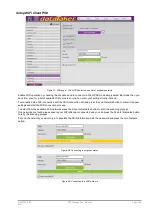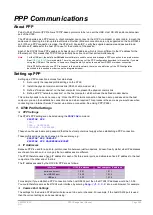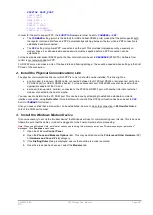
UM-0085-B09
DT80 Range User Manual
Page 257
RG
Troubleshooting
If you experience problems connecting to the
DT80
FTP server, it can be helpful to examine the raw FTP messages that
are being exchanged. To enable display of received and transmitted FTP messages, set
P56=8
. For example:
P56=8
>> 220 dataTaker FTP Server ready. Type HELP for help
<< USER anonymous
>> 331 User name okay, need password.
<< PASS IEUser@
>> 230 User logged in, proceed.
<< syst
>> 215 UNIX Type: L8
<< PWD
>> 257 "/" is current directory.
<< CWD \b:\
>> 250 Requested file action okay, completed.
<< TYPE A
>> 200 Command okay.
<< PASV
>> 227 Entering Passive Mode (192,168,1,202,14,183)
<< LIST
>> 150 File status okay; about to open data connection.
>> 226 Closing data connection. Transfer succeeded
This shows an anonymous user logging in and requesting a directory listing. Lines beginning with
<<
were received by
the
DT80
, while
>>
indicates lines that were transmitted by the
DT80
.
Note:
this setting will also show exchanges between the
DT80
and an external FTP server – for example when unloading or copying
archive files to an FTP server (see Retrieving Logged Data (P97)).
Security
Basic Security
If the
DT80
is made visible on the Internet then you should carefully consider the security implications of this.
With a public IP address, the logger will be visible and accessible by anyone on the Internet. This may make it vulnerable
to disruption by malicious software that exists in the wilds of the Internet.
Given the specialised nature of the
DT80
's operating system, it is highly unlikely that any type of computer virus would be
able to be loaded onto the
DT80
.
However the network services provided by the
DT80
may be vulnerable to disruption. For example, if the
DT80
's FTP
server is enabled then it may be found by an automated "port scanner" program, which may then repeatedly attempt to
guess the FTP server username and password.If successful, it would then be able to access and delete files on the
DT80
's internal file system.
To minimise the risks, there are a number of measures you can take:
•
Disable any servers that are not required, using the appropriate profile settings, e.g.:
PROFILE FTP_SERVER PORT=0
PROFILE HTTP_SERVER PORT=0
PROFILE MODBUS_SERVER TCPIP_PORT=0
PROFILE COMMAND_SERVER PORT=0
•
Use non-standard port numbers, e.g.
PROFILE FTP_SERVER PORT=2100
PROFILE HTTP_SERVER PORT=8000
PROFILE MODBUS_SERVER TCPIP_PORT=50200
PROFILE COMMAND_SERVER PORT=7709
which may fool casual hackers. When legitimate users connect they will need to specify the port number, e.g.
http://mylogger.com:8000/
•
Enable the command server password (see
), e.g.
PASSWORD=zx81
SIGNOFF
















































